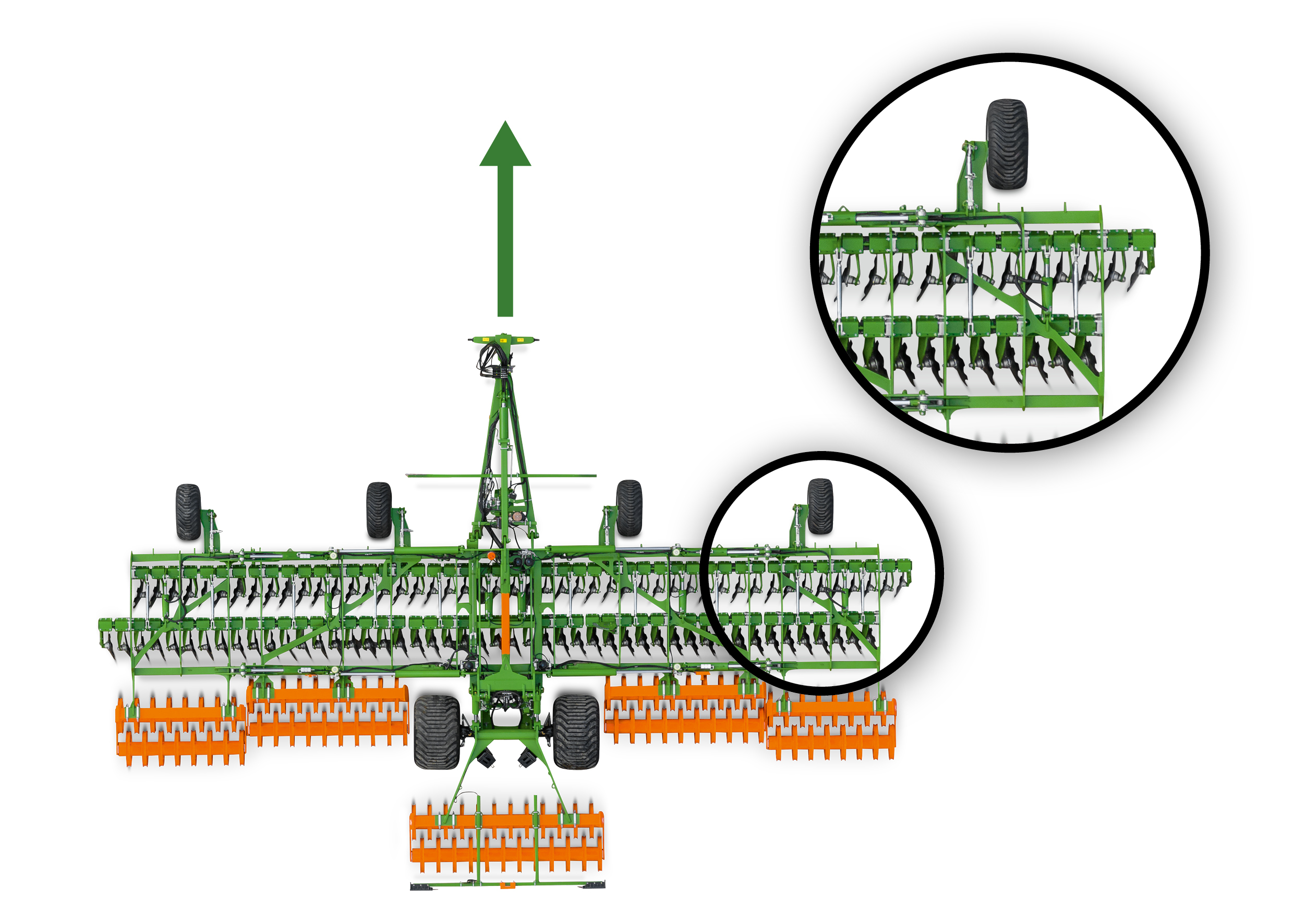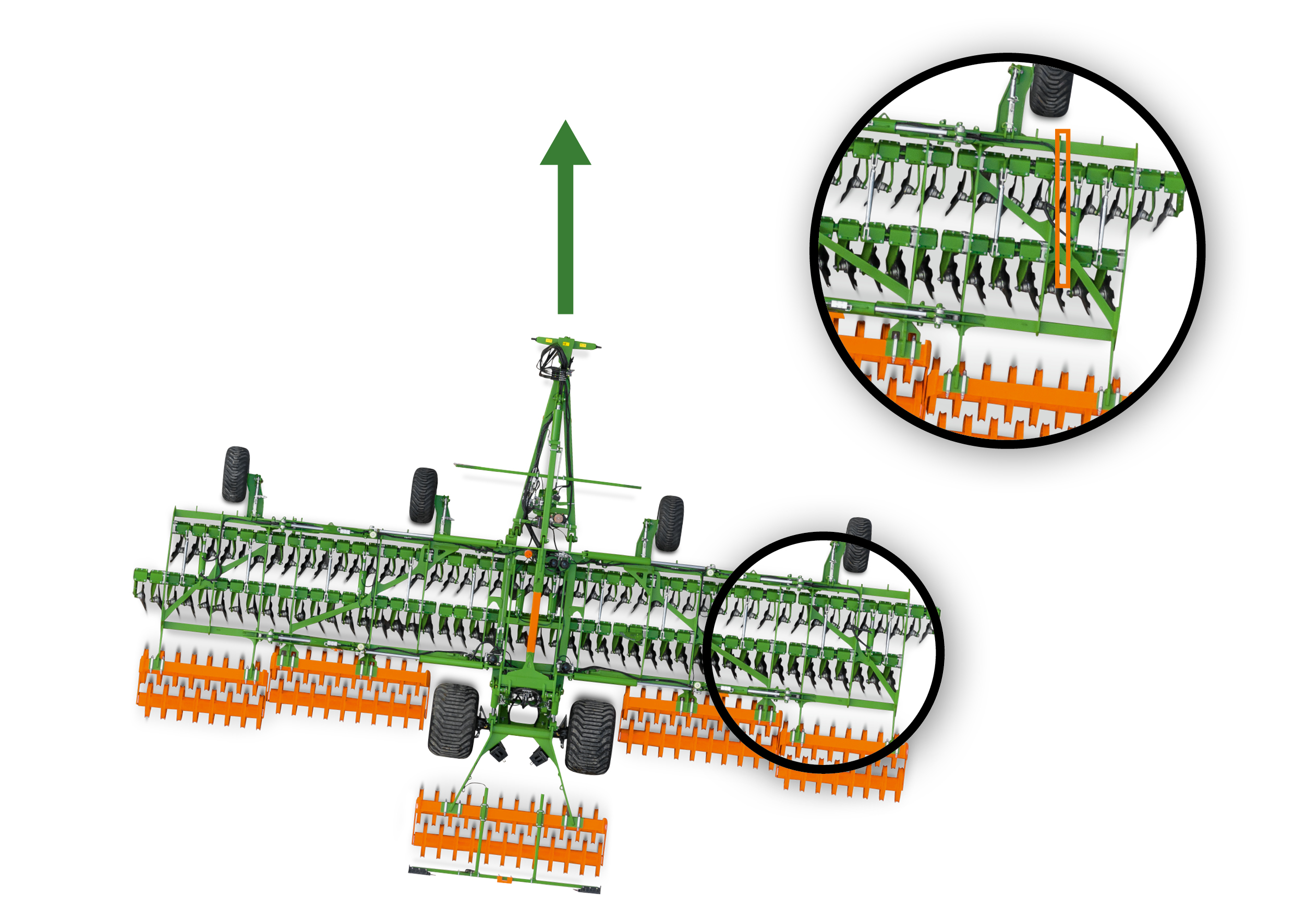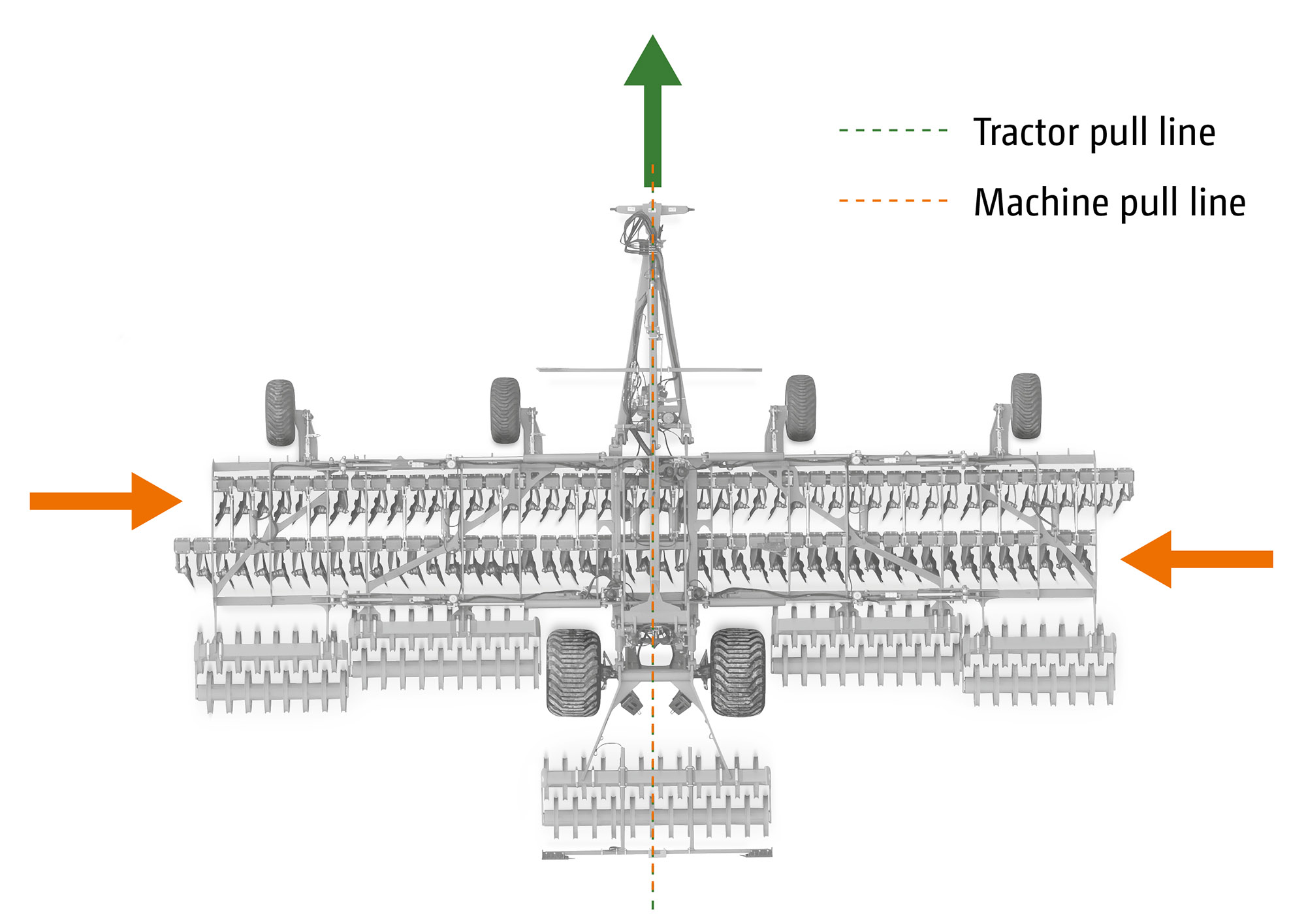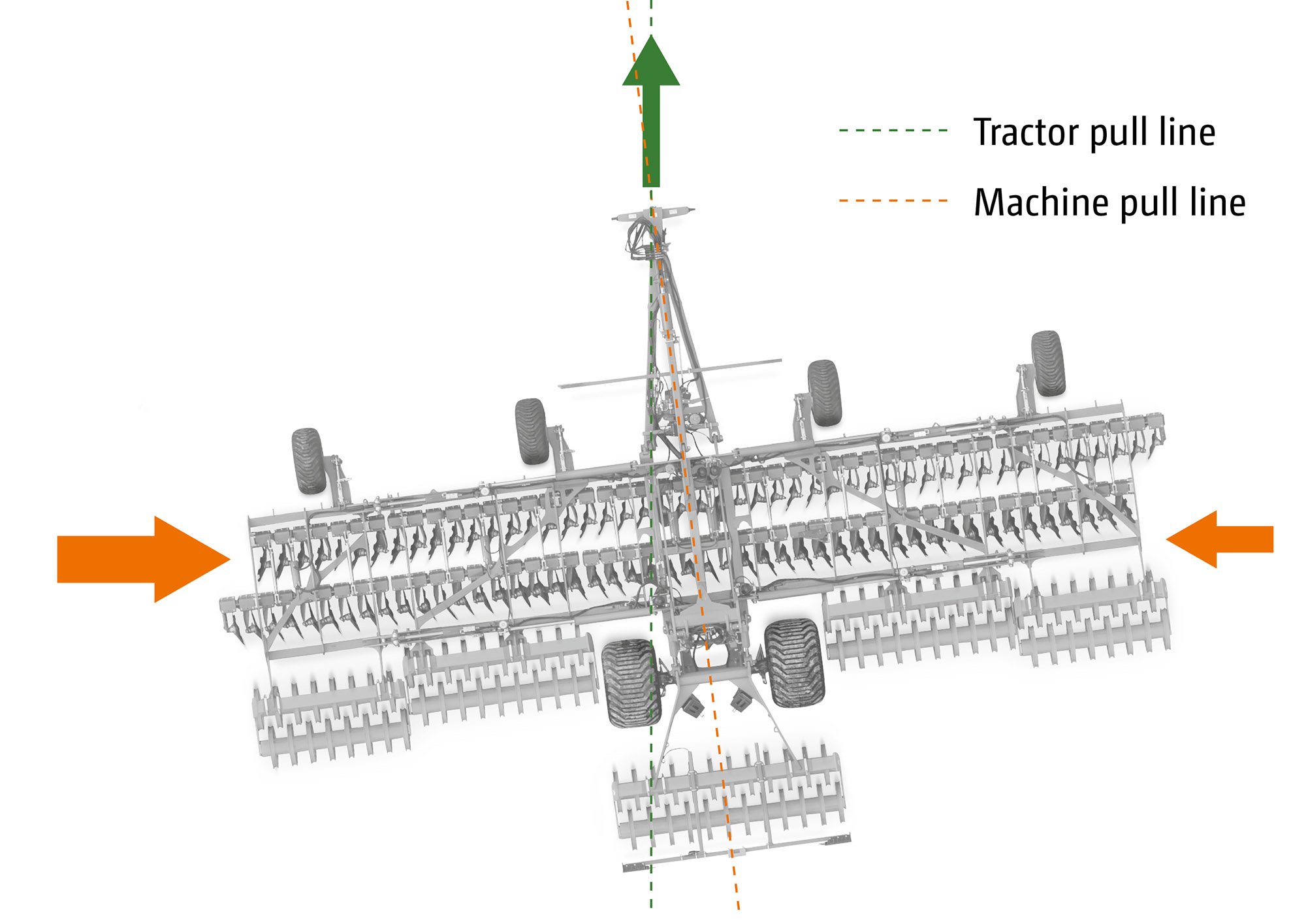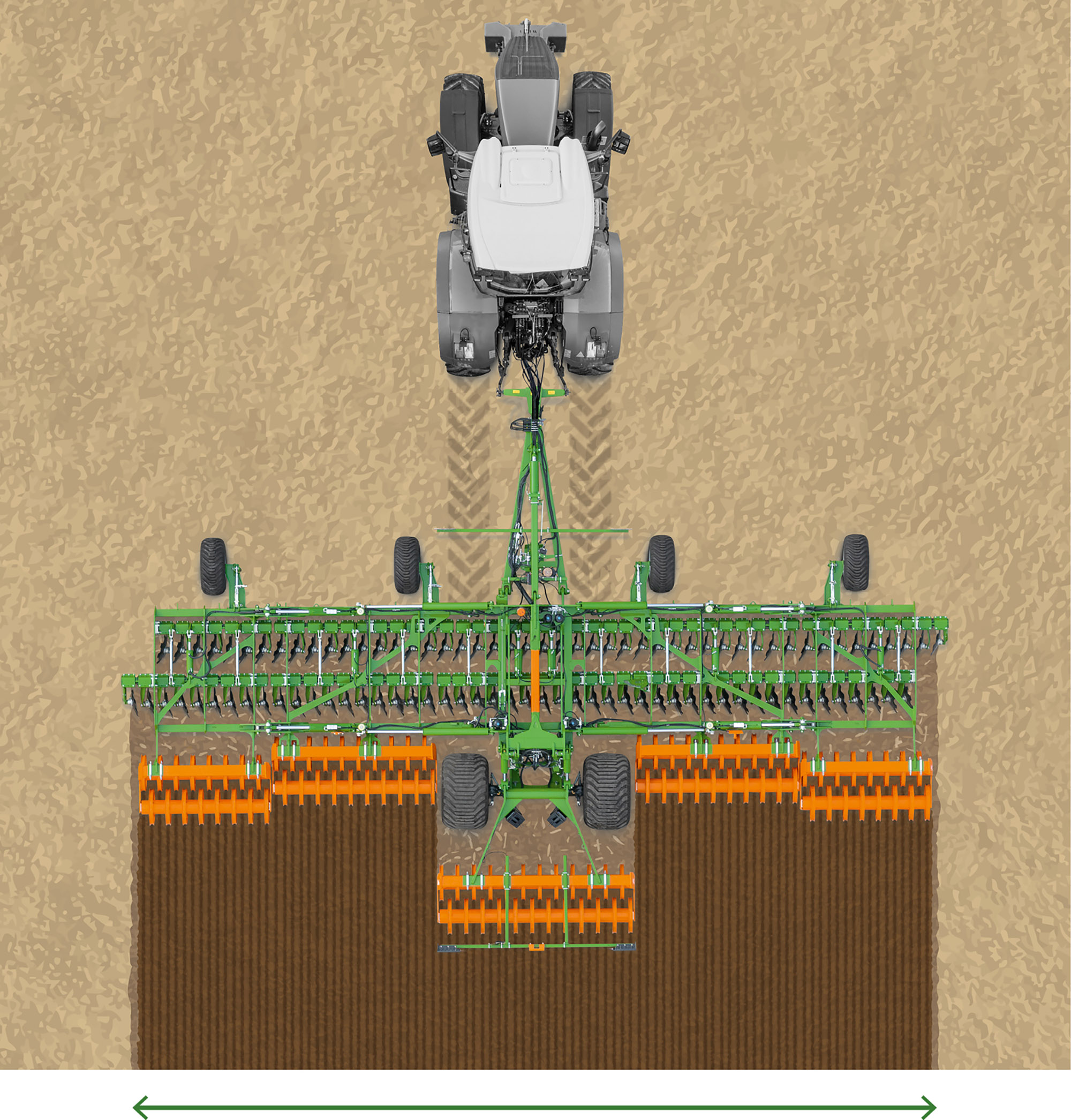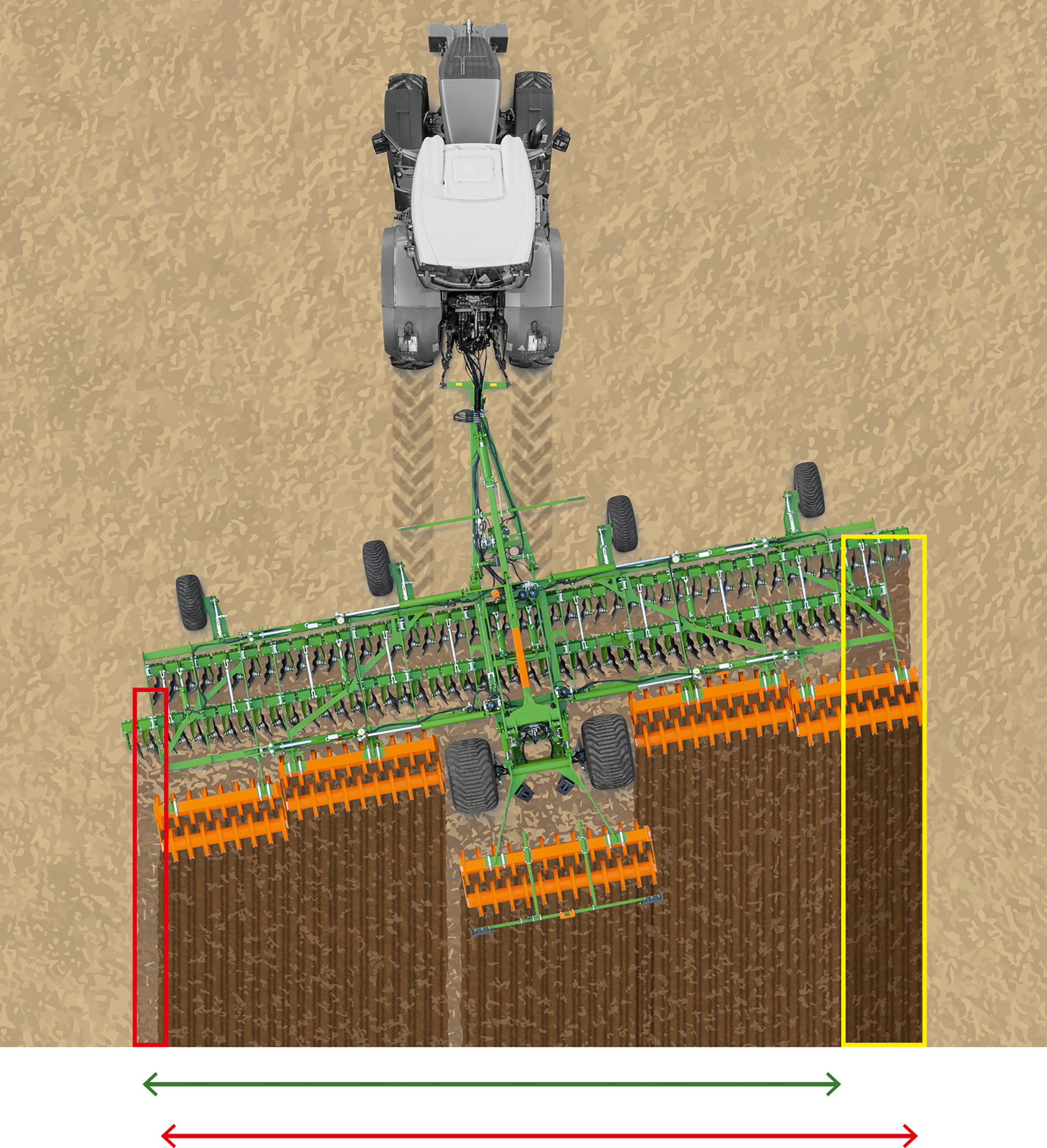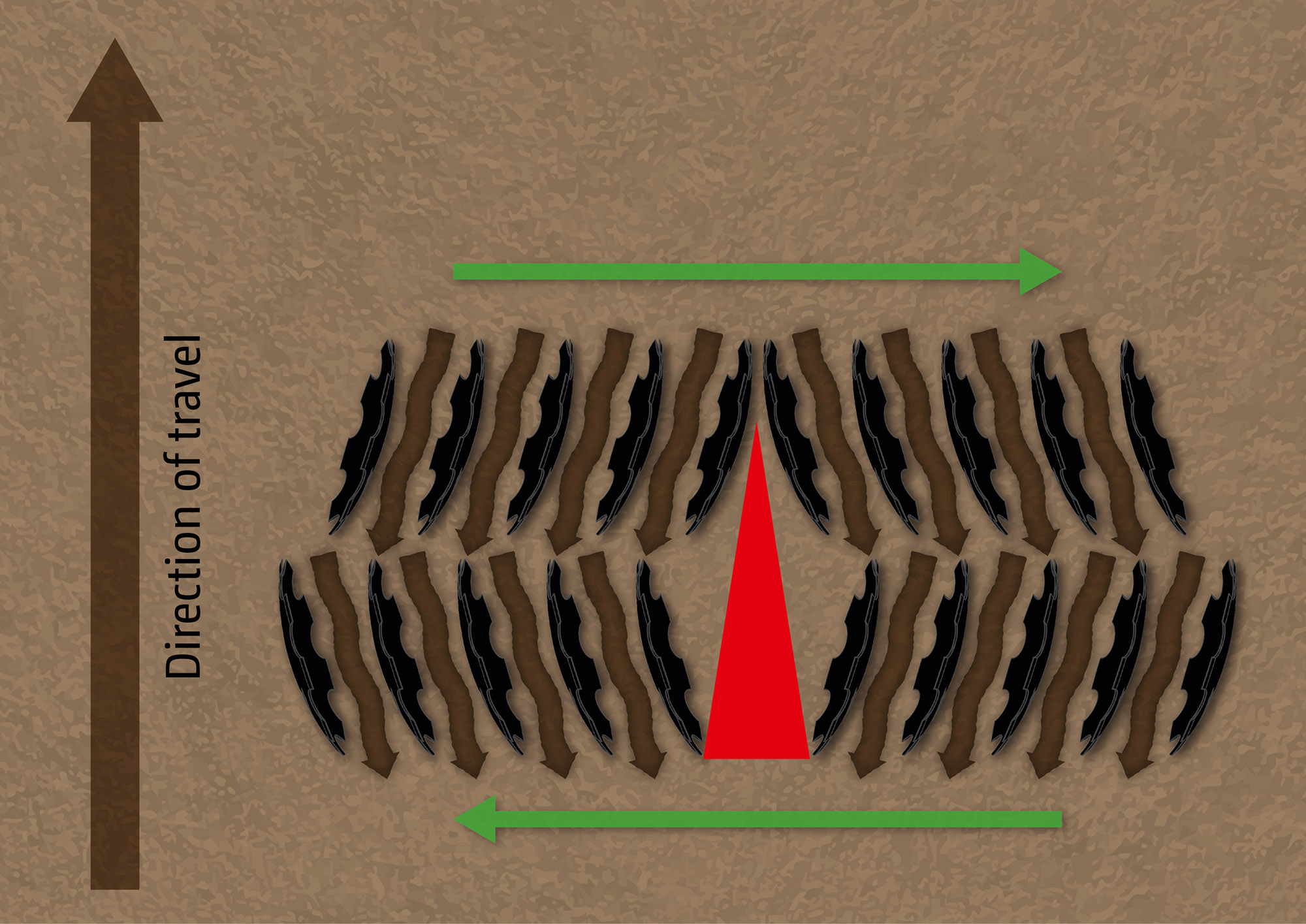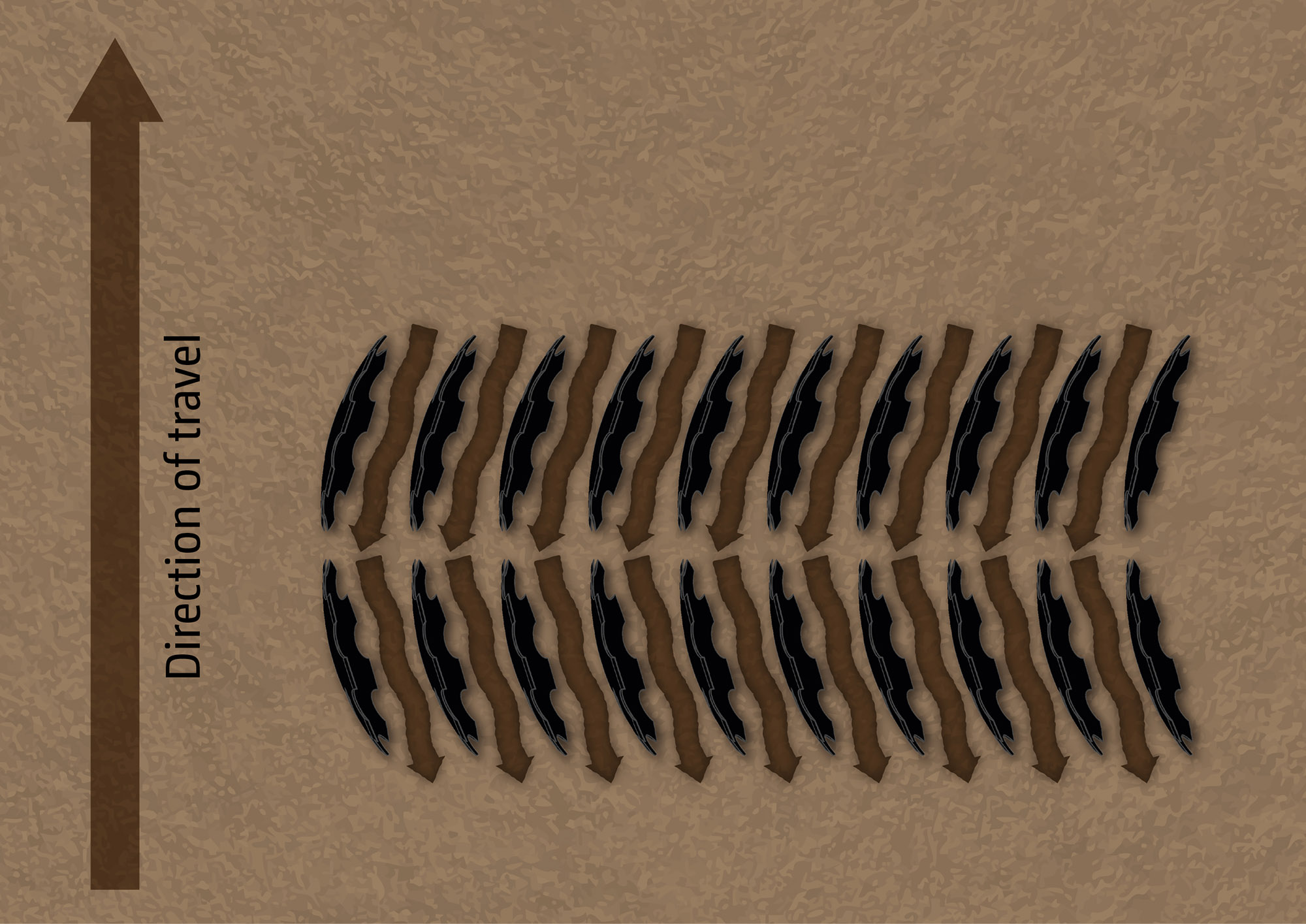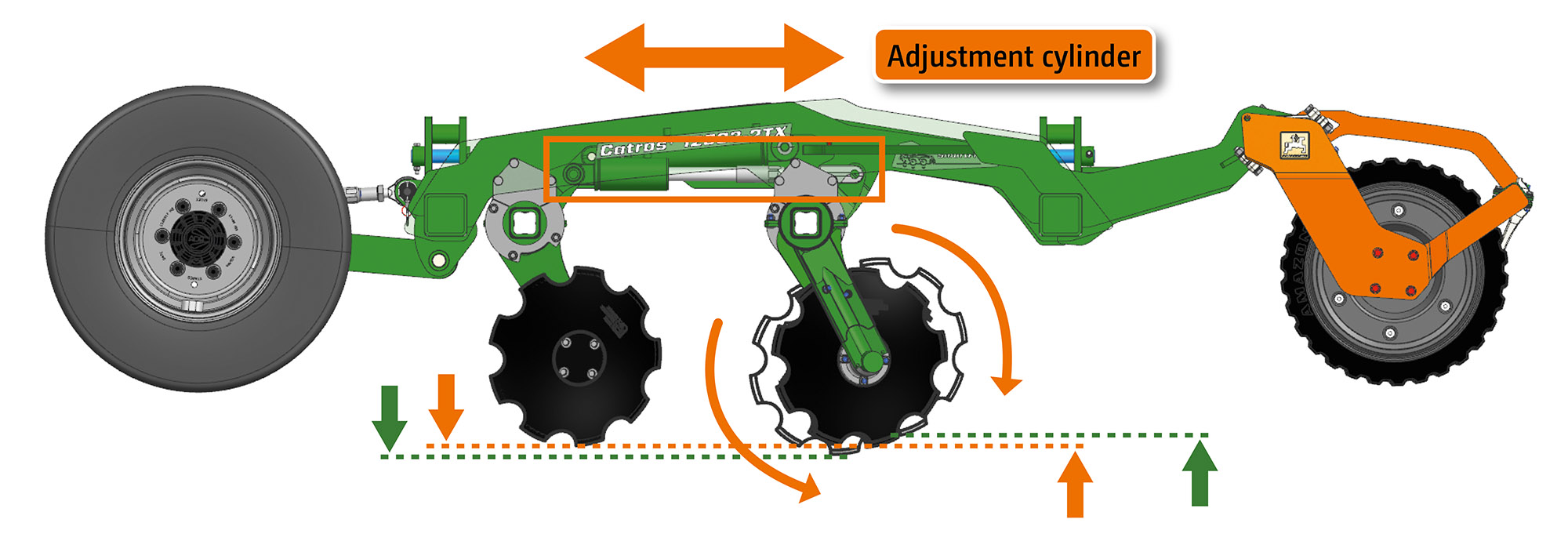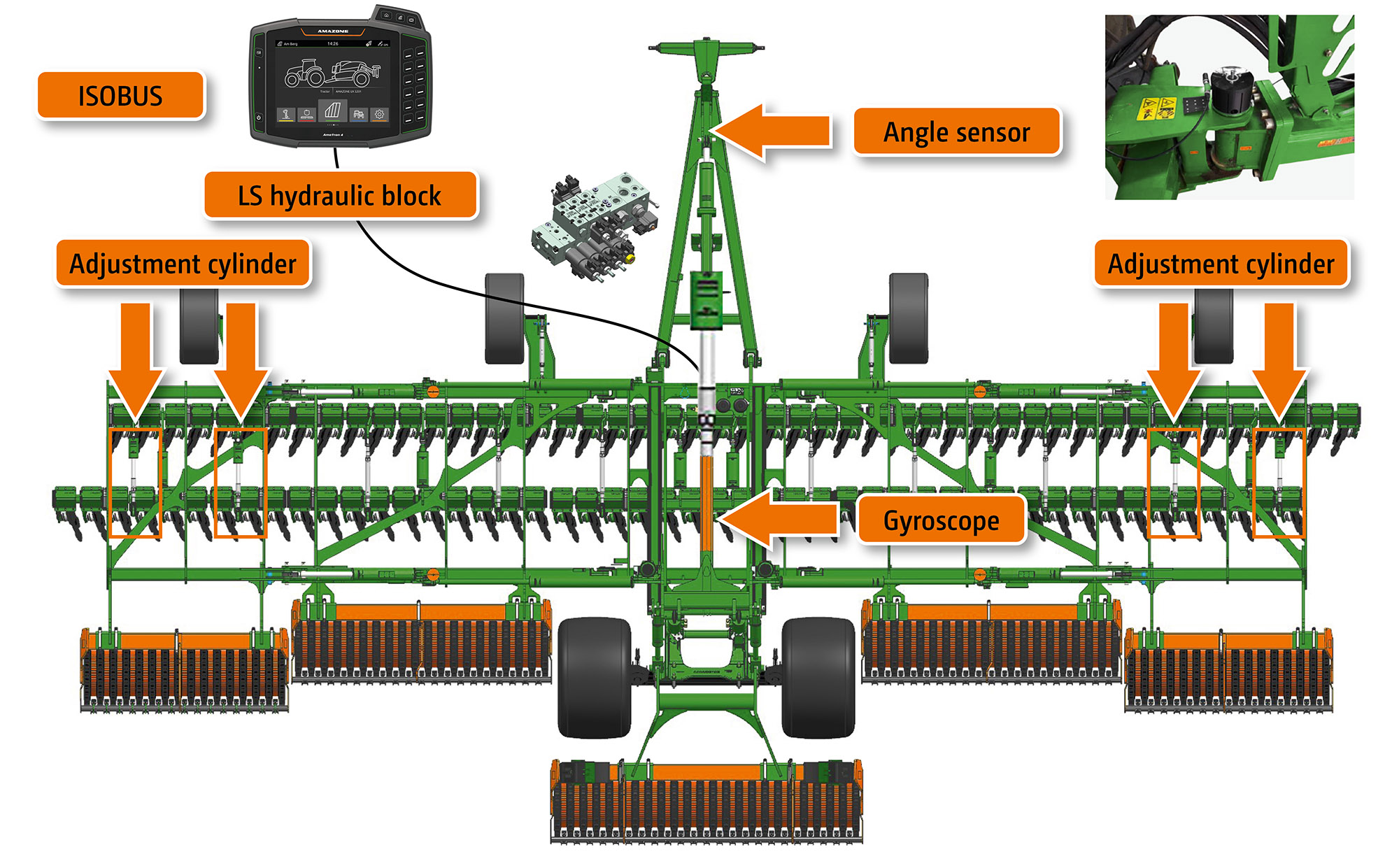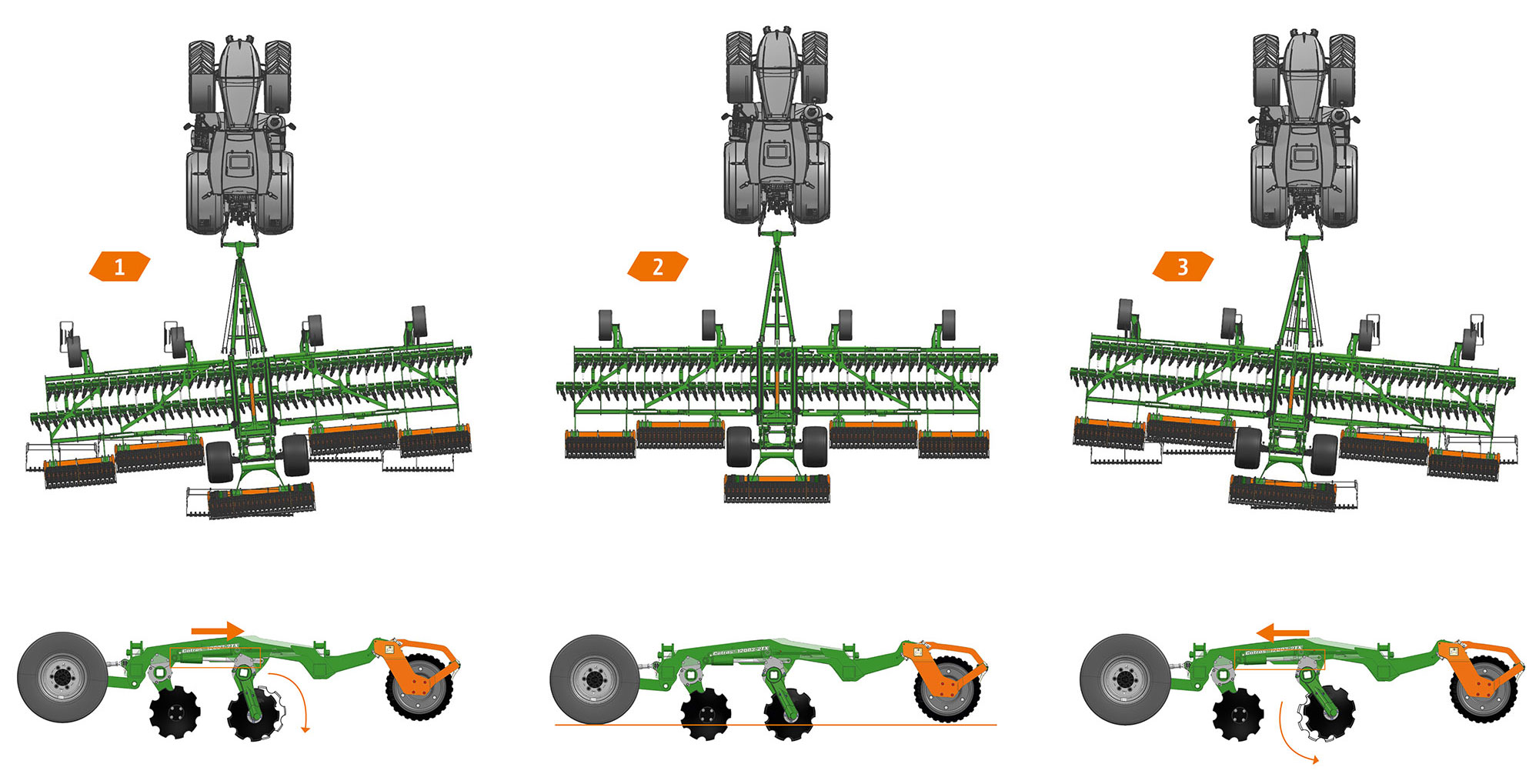AutoLane - keep uphill automatically with innovative soil tillage
AutoLane automatic tracking system for the Catros-2TX
Today, tractors with automatic track guidance are often used for soil tillage, which can follow fixed A-B lines or contour lines. These A-B lines are set based on the working width and the mounting position of the implement.
It is theoretically assumed that the implement runs straight behind the tractor when on a slope. In practice, it has been shown that, especially with trailed soil tillage machines, such as the compact disc harrows, the machine runs downhill on hilly terrain, and therefore no longer follows in the tractor's track.
This means that the actual area worked does not match the theoretical area in the guidance system, with the result that some areas are worked twice and some not at all. This is because, in practice, the track offset is not usually corrected by the slope drift every time the direction changes. In addition, the inclination of the slope is not the same over its entire length of the field. However, the varying drift is not corrected during a pass.
The result produced by the implement is also not optimal, since the soil engaging metal is not optimally matched to each other when the machine is running at an angle, which means that the ground is no longer worked over its entire surface. When the pull is on the diagonal, the second row of discs can run exactly in the working zone of the first row, leaving the area in between unworked. Or, the roller does not reconsolidate where the discs are working, due to the angled offset. Uneven incorporation and reconsolidation prevent the rapid and even emergence of volunteer cereals, increase weed pressure and thus has a negative impact on the following crops.
In addition to the hilly terrain, an additional influencing factor for non-tracking can be the difference in disc wear between the first and second row of discs. The discs in the first row tend to wear faster, since these discs are working on the yet to be cultivated ground whereas the second row of discs works in the already pre-loosened soil.
In addition, disc harrows with a V-profile disc layout can also have the problem that they do not always run true to track behind the tractor on highly variable soils.
With a V-profile, as with all AMAZONE disc harrows, the discs are arranged pointing in opposite directions from the first to the second row of discs. This even arrangement of the discs per row results in a regular disc spacing across the entire working width. This ensures consistent quality across the entire working width compared to an X-profile disc layout.
Basically, if the implement is not tracking true, whether on a slope or on flat terrain, this means that the tractor's traction line is not optimal, which means that the power curve of the combination is not optimal.
State of the art
With trailed compact disc harrows, there is currently no effective technical solution to prevent the implement from running downhill. There are special slope discs in some areas that can reduce, but not prevent, this phenomenon.
In order to counteract the problem of overlapping and skipping when driving track by track on hilly terrain, an additional GPS receiver could be used so that the track guidance system can adjust the A-B line of the tractor. However, this does not compensate for the diagonal pull of the implement. By shifting the A-B line to the previous track, only an overlap of the working passes is created so that no area is left unworked. Even with this approach, the result from the compact disc harrow is poorer and the traction line is not optimal.
Existing concepts, for instance with an X-profile layout of the discs in 2 rows, ensure almost lateral force-free straight running on variable soils on the flat thanks to a balance of forces in the disc layout. It is noticeable that disc harrows with an X profile oscillate around the centre position and here too the actual working width deviates from the theoretical. To compensate for this oscillating pendulum movement, a reduced working width must also be entered in the steering system. On slopes, however, the X-profile layout does not prevent drift either.
The X-profile layout format has the great challenge of arranging the opposing discs per row in the middle in such a way that full-surface coverage can be achieved under all conditions. The area in the centre (red triangle) is usually insufficiently covered, and incorporation is often not uniform, depending on the conditions. The machine has a negative influence on the soil flow, which, depending on the soil type, can lead to an uneven result behind the trailed unit, due to the lateral distribution of soil and organic matter.
The new AutoLane system
To meet this challenge, AMAZONE is presenting AutoLane at Agritechnica 2025, a new, innovative system that compensates for the slope drift of compact disc harrows and compensates for double passes and missed areas on slopes and in varying soil conditions. The offset of the trailed compact disc harrow to the tractor is constantly measured by an angle sensor and is processed in the AmaTron 4 ISOBUS terminal. The inclination of the disc harrow on hilly terrain is assessed by a gyroscope to generate an active position measurement.
Based on a known line that mirrors the drift on the slope, a target angle between the tractor and disc harrow is determined and set by the system. Deviation from the target angle triggers the rear row of discs to shift, which results in the disc harrow being pushed uphill in the opposite direction if it drifts downhill. If the working depth of the rear rows is increased slightly, the disc harrow moves to the left. However, if the working depth of the second row of discs is reduced slightly, the implement pulls to the right. As a rule, minimal adjustment of a row of discs is sufficient, so that the influence on the working result is negligible. The tried and tested AMAZONE SmartFrame enables the rows of discs to be adjusted in relation to each other. The permitted stroke lengths of the adjustment cylinders are limited to maintain the current working depth. The integration of electro-hydraulic components, various bearing sensors and angle sensors and the ISOBUS control system will form the basis for AutoLane on the Catros-2TX.
The system-related difference in disc wear between the first and second row of discs (the first row has higher wear) can also be detected with AutoLane via the change in the side forces. The deviation from the line caused by worn discs is automatically compensated for.
Automation of the true tracking by the AutoLane
- With AutoLane, the AMAZONE Catros-2TX compact disc harrows track behind the tractor accurately in a wide range of conditions. It doesn't matter whether it be on hilly terrain or in extremely fluctuating soil conditions.
- Unworked areas are avoided, volunteer cereals are stimulated to germinate evenly and weed pressure for subsequent crops is reduced. Additional measures for weed control can be reduced.
- Damage to the soil structure and soil water loss through evaporation due to double tillage are reduced.
- Fuel and working time are saved and wear is optimised.
- Track offset due to system-related, differing wear of the discs from the first to the second row of discs is detected by the AutoLane and automatically compensated for.
- Sensor-controlled, electro-hydraulic systems also provide the basis for future, fully autonomous working whereby the operator doesn’t need to directly influence the result ensuring consistent quality.
- AutoLane increases ease of use by automatic control and is therefore easy and user-friendly to set up, even for untrained and inexperienced drivers.
Gallery
